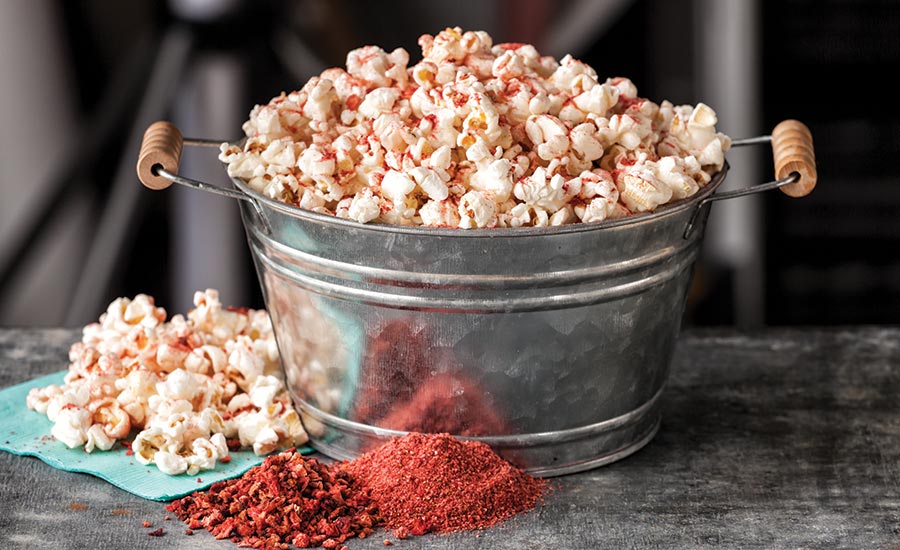Herbs, Spices, and Flavorings Add Adventure, Taste, Health, and Color
Chefs strive to please an increasingly adventurous, yet demanding, consumer


Seasonings are about more than herbs and spices; extracts, elixirs, fruit and vegetable powders, and condiments all contribute to a flavor symphony.
PHOTO COURTESY OF: Kikkoman Corp. (www.kikkoman.com)

The expanding array of options for seasoning foods grows as ingredient technologists improve natural flavor preservation in herbs, spices, powders, and extracts.
PHOTO COURTESY OF: Nu Products Seasoning Co. (www.nuproductsseasoning.com)

Prices of exotic spices are often high, but with higher quality and consistency
available, they’re easier to use and add marketable cachet.
PHOTO COURTESY OF: Vito Gnazzo/The Leopard at des Artistes (www.theleopardnyc.com)

New methods of infusing smoke into salt and spices allows for both clean flavors and clean labels.
PHOTO COURTESY OF: SaltWorks, Inc. (www.seasalt.com)

More than spices and herbs, reductions, extracts, concentrates, and powders from fruits, vegetables, spices, and even wine and spirits are part of the seasonings toolbox.
PHOTO COURTESY OF: Mizkan America, Inc. (www.mizkan.com)

Seasoning solutions can be provided as customized drop-in pre-blends to ensure consistency of flavor, color, and texture in batch
formulations.
PHOTO COURTESY OF: Givaudan Flavors Corp. (www.givaudan.com)







Now that the annual season of pumpkin spice, peppermint hot chocolate, and other holiday flavors of fall and winter has passed, research chefs and product developers are gearing up to embrace the food and flavor trend predictions for the new year. Eager to mine those predictions for nuggets of inspiration that will lead to new ideas and flavor profiles, chefs strive to please an increasingly adventurous, yet demanding, consumer.
The 2010s delivered an expansive consumer awareness of, and attraction to, North African and Middle Eastern flavors. Spices and flavor blends such as za’atar, sumac, harissa, dukkha, and ras al hanout abounded. At the same time, the decade also saw significant growth in consumer interest in the regional cuisines of Southeast Asia, which helped reinforce the applications of lemongrass, kaffir lime, and tamarind in foods and beverages.
At the same time, Southeast Asian culinary traditions have been introducing US consumers to jackfruit, durian, and banana blossoms, as well as more exotic versions of familiar spices, such as Kampot pepper (a Cambodian cultivar of black pepper) and shishito chili peppers.
Turmeric is another example of a fast-trending spice that is entering this decade as a household word. Prized not only for its flavor contribution to Indian and South East Asian foods, turmeric also is widely praised and sought after for its anti-inflammatory properties. The recent burst of interest in the exotic spices of South Asian cuisine is driving renewed interest in coriander, fenugreek, cumin, and cardamom.
Cardamom has been utilized liberally and extensively in the East, Middle East, and Africa. It is a common infusion in Turkish coffee and a major spice flavoring for grilled meats such as shawarmas. Known as the “queen of spices” and originating in southeast India, cardamom was brought into Northeastern Europe and Scandinavia by the Vikings. That makes cardamom unique in the US, where it is associated with two vastly different but equally vibrant culinary cultures.
Cardamom is an indispensable spice in many Swedish and Danish pastries. It also is a key spice in Indian chai, the spiced tea that has experienced ongoing popularity in the West for years. The westward migration of authentic cuisines that are fueled by cardamom, cumin and other spices has both stimulated greater interest in these spices and extended their use into other cuisine styles.
AROMATIC AWARENESS
Another spice that is straddling several completely different food cultures is fennel. It is used in Indian curry dishes, Middle Eastern seasoning blends, and Western European foods, especially Italian cuisine. Rarely used in this country outside of those dishes, possibly due to its strong licorice flavor (it is a relative of anise and the root bulb of the plant often is mislabeled as anise), the popularity of fennel root among American chefs a generation ago opened domestic palates to all things fennel. The versatile spice is a mainstay of Ayurvedic and Traditional Medicines for its purported health benefits, especially as an aid for digestion.
Fennel seed — and, in fact, other powerful aromatic seeds such as cumin and caraway — are best when slightly toasted before use to release the volatile oils that carry their flavors and aromas. They also should be ground from whole seed immediately before using, as pre-grinding causes those same volatile compounds to dissipate rapidly. (Dried peppercorns also benefit from grinding just prior to use.)
Fennel pollen is making a comeback as a way to add a burst of fennel flavor with virtually no prep. It is more costly than fennel seed, but a little goes a long way. “Fennel pollen has been a treasured ingredient in Italy for centuries,” notes Vito Gnazzo, chef of The Leopard at des Artistes in Manhattan. “The wild fennel flower is basically a dot of yellow pollen on the end of a small stem, surrounded by miniscule petals, almost too small to notice.”
Gnazzo harvests his own fennel pollen by hand in his rural property back in Salerno. The flowers are placed in cloth bags to prevent moisture from collecting and creating mold. After harvesting, the flowers are carefully spread on wide wooden boards lined with butcher paper in a well-aerated, dry room.
The boards are not disturbed during drying to ensure that the pollen’s essential oils do not dissipate and lose their rich scent. Gnazzo describes dried fennel pollen as “a chef’s ‘cheat code’ because its heady floral aroma, golden-green color, and crisp texture are virtually guaranteed to add exciting flavor and aroma notes to dishes.
Gnazzo uses the ingredient in a variety of applications. “It has a knack for amping up dishes, from vegetables to pastas and makes a perfect combination with meat, making for a perfect rub especially on veal and pork,” he says. The powerful spice offers notes of citrus and licorice with a slight woodsy hint.
APPLICATION RECEIVED
In addressing the consumers’ growing interest in more adventurous and complex flavors, even the larger food companies have begun to push the flavor envelope. They put complete trust in their research chefs, most of whom came out of the highly competitive restaurant scene. Those chefs, in turn, tapped directly into the pulse of what the modern consumer is demanding in the way of flavors and seasonings.
For example, PepsiCo./Frito Lay launched its “Do Us A Flavor” campaign about a decade ago to solicit flavor combinations from the public for its snack chips. The first launch brought as the three top potato chip flavors Sriracha, Cheesy Garlic Bread, and Chicken and Waffles. All three flavors did well when launched, but the Sriracha flavor threw open the doors for new and exciting explorations in spicy flavors.
On the other hand, with the Cheesy Garlic Bread, it was established that today’s consumers will responded positively to more complex, layered flavors. The seasoning profile for that item actually consisted of at least three different types of garlic and five different cheeses.
In developing a new cheese flavor, the challenge arose of how to evoke the mouthfeel of dairy on a snack chip with seasoning alone. The solution was to create a more composed experience that paired the dairy flavors with the flavors of common, identifiable foods in a way that served to trigger imagery, memory, and the emotional experience of tasting the food in its analog form.
The third flavor in the launch, Chicken and Waffles, was devised as an artifact of the growing popularity of sweet and savory combinations. Similar to the salted caramel/salted chocolate trend that immediately preceded it. That profile and the profile of sweet and spicy presented specific seasoning challenges as well.
Conventional technology in seasoning application for snack foods includes conveyor-based dusting systems, drum-based single-stage dry flavor application, drum-based two-stage oil and dry flavor application, and a drum-based slurry system.
These systems can be used for, fried, baked, popped, and extruded snack forms. When you introduce a seasoning that has a considerable amount of sweet hydroscopic particulates such as sugar, it is necessary to allow for all the variables of flowability and residue.
Another consideration, of course, is both the shape and texture of the base receiving the seasoning. For example, in developing a flavored shaped corn chip, traditional seasoning application systems are not always an option. The temperature of the base can also prove problematic if there wasn’t enough dwell time to allow the shells to cool after being fried, much of the volatile flavors in the seasoning can be lost.
In these cases, a two-stage coating system is the best choice. This is a common solution used in snack manufacturing to provide a consistent, uniform application of liquid and dry coatings. It also works well for extruded products, and can aid in top-noting fried and baked snacks with oil-soluble flavors.
For ready meals that go through cook/freeze/reheat cycles, other considerations affect application of herb and/or spice seasonings. “We have been making prepared seafood meals for more 25 years and still one of the biggest challenges is allowing for the variability in flavors and textures generated by home microwaves,” explains Jim Morones, vice president of product development for Aqua Star, Inc., one of the country’s largest makers of frozen specialty seafood products makers. “Dry seasonings and herbs are great in delivering flavor, but can burn if a consumer cooks the meal too long or at a power that is too high.”
To solve this for the company’s new MicroSteam Meals line, Morones and his team developed ingredient and flavor combinations that pair dry herbs and spices with chef-designed sauces tailored to carry and hold specific complementary flavor notes. “The result is a greater depth of flavor, even when the cooking isn’t executed perfectly,” Morones says.
SALTS ARE SMOKIN’
Smoked salts allow for enhancing the flavor of grilled meats and vegetable without having to cook over wood. While smoked salts have grown in popularity, the recent development of new techniques that allow for “cold” smoking the salts via infusion has taken them to the next level, ridding them of any bitter notes or harsh, overwhelming flavor.
There is an added benefit to using cold-smoked salts in industrial applications they lend themselves to clean labeling. Moreover, the new smoked salts that are produced with an infusion process yield simply mineral or sea salt and smoke flavors, nothing harsh and no bitter notes.
According to a statistical report by the American Spice Trade Association (ASTA), other flavored salts accomplish this as well. Chili pepper-flavored salts are the fastest growing in popularity, as well as salts combined with or flavored with other hot spices, such as black pepper and mustard. These products provide dynamic sensorial contrast without the deep complexity of traditional spice blends. Other blends endeavor to amplify savory and umami notes. These include salts with truffle, porcini, and even black garlic.
IN THE BLACK
Commonly mistaken for as a result of fermentation, black garlic is garlic that has been aged in a warm, humidity controlled environment for several weeks, creating a slow Maillard reaction. The result is dark, soft cloves with a savory-sweet flavor. Within the realm of spices and flavors, black is a “seductress,” indicating depth and complexity of flavor.
In addition to the ubiquitous black truffle, food product developers are steering toward black sesame seeds and nigella seeds. Also known as kala til, black sesame seeds are said to be one of the oldest condiments known. Aside from their nutty flavor, they have a variety of perceived health benefits such as lowering blood pressure and aiding in digestion. Black sesame seeds can be used whole in common cereal applications, or as a paste, such as black tahini.
Nigella seeds are often mistaken for black cumin. They have a flavor that is described as a combination of onion and caraway and commonly used to flavor Armenian style string type cheeses, as well as pickles and preserves. Nigella seeds are also are used in ethnic nut-spice blends, such as dukka, the newly trendy Egyptian condiment. Dukkha is traditionally a combination of herbs, nuts, and spices and, in addition to being used as a seasoning, it also is served as a tableside condiment for dipping oiled bread or fresh vegetables into.
Black mustard seeds are finding their way into new products, and are included not only for their sharp flavor and nutty aftertaste, but for their snappy, popping texture as a pickled condiment used whole in mostardas. For a more complex and dynamic experience a mixture of different colored mustard seeds can be used providing, contrasting size and pungency.
SEASONED CHOICES
One of the first decisions for food product developers is which forms of spices will be utilized in specific applications. Dried spices have a particular set of challenges.
Flavor intensity can be compromised depending upon their quality and age. This can also affect the appearance of the finished product.
If the developer chooses to forgo anti-caking agents in an effort to provide a clean label, there is a risk of agglomeration resulting in hot spots and uneven flavor. To avoid this, extracts can be employed. They are more concentrated than dried spices and provide greater consistency. This allows them to be used to more precision, resulting in more consistency in the finished product.
Extracts also mitigate potential contamination as they are free from microbes. Essential oils and oleoresins can be encapsulated to retain the more volatile flavor components; however, this process often introduces modified starch, dextrose, and maltodextrin, making clean label more challenging.
When choosing spice forms, it is important to consider which properties are to be primary. First and foremost is basic taste. This provides the skeleton of salty, sweet, sour, bitter, and umami on which the other applications are layered. Flavor goes hand-in-hand with aroma, as it is the scent components that provide the majority of perceived flavor. It is important to keep in mind that the consumer experiences food with all the senses.
Without appearance and texture taken into consideration, flavor, texture, and aroma constitute an underdeveloped proposition. With regard to appearance, vegetable powders such as beet and carrot can be employed for coloring as well as flavor. (This helps contribute to a cleaner label, but it should be noted that such ingredients cannot be claimed as a “natural color” if the original color of the food product in which they are used is dissimilar.)
Dried and fresh herbs can contribute visual interest as particulates, but they should be top-noted with an encapsulated essence to deliver fresh flavors. For texture, there is not only the choice of whole or ground spices but, piece-size of fresh seasoning components like onion, garlic, ginger, and chili peppers.
With so many options for adding seasoning to food and beverage products, developers are freer than ever to experiment with new and exciting flavor combinations. Increased availability of once-rare spices and support from more engaged spice and flavor companies are bringing prices of such experimentation within the reach of food companies that might have been more risk averse in the past. With this in mind, it’s safe to say that the 2020s will be a well-seasoned decade for the food industry.
Stephen Kalil is a Certified Executive Chef (CEC) with the American Culinary Federation and a Certified Research Chef (CRC) with the Research Chefs Assn. In both organizations, he has served as president. Kalil has decades of experience in product development for restaurant groups, such as Brinker International, and food product manufacturers, including more than a decade as the Corporate Executive Research Chef for PepsiCo/Frito Lay. He currently is founder and strategic leader of culinary innovation for the Flavor Design Studio, a think tank and consultancy in Dallas, Texas. Chef Kalil can be reached at chefstephen@flavordesignstudio.com.
SPICE SOURCE
Unlike with most other food products, the term “locally sourced” for spices is counterintuitive. Whereas it is easy in the US to get fresh or hydroponically grown herbs, as well as garlic, onions, paprika, and mustard seed, and Canada provides coriander and caraway, most spices are outsourced, and typically from developing countries. India is a country of origin for black pepper, turmeric, celery seed, and cumin; cinnamon, nutmeg, and vanilla are provided by Indonesia; ginger and sesame seed largely comes from China; and chili peppers typically come from Mexico. Today’s consumer wants to know what herbs and spices are in a product and where they come from. Consumers as well as manufacturers have become highly conscientious about where spices originate, how they’re handled, and the impact their sourcing is making on people and the environment. The source and narrative of ingredients are highly important. Professionals in food, whether research chef or food scientist, are tasked with being more knowledgeable than the consumer as to the qualities, attributes, and specifications of the food product ingredients being used.
IN THE PINK
Specialty salts, especially sea salts, have been popular with chefs and home cooks for ages. But the past decade has seen prepared food makers jump on board. The market for global and flavored salts is predicted to surpass $2.4B by 2024, according a 2019 report by the research group Mordor Intelligence. Not only do such high-end salts add more flavor, they have the cachet of being considered more “natural” and healthier somehow than regular iodized salt.
There are two segments within the “gourmet salt” category. Flavored salts — mineral or sea salt combined with spices, herbs, chili pepper, or other seasoning; and so-called “global” salts which are identified by the source and region from which they were derived. Of these, pink Himalayan salt is the most ubiquitous in the foodservice industry.
Restaurant chefs have been using pink salt not only as a finishing touch on meat and seafood, but also using for aesthetics and function. In consumer packaged goods, pink salt is a prominent ingredient in such diverse applications as Vosges’ Goji and Pomegranate chocolate bar and PepsiCo’s Red Rock Deli brand of potato chips.
One caution to product makers is that, due to a combination of increasing shortages of Himalayan pink salt and its popularity driving ever-higher demand, poor quality and “diluted” product has flooded the market. Worse, due to a loophole, the purity and safety of many of these imported global salts cannot be assumed.
The loophole is that they enter the country in bulk as ingredients to be further processed, yet unscrupulous providers do no further processing beyond repacking the contents into smaller packages. In many cases, they mix in as much generic salt as possible while still retaining an overall pink hue. Close inspection can reveal that half or more of the salt is not actually pink. Processors wanting to use such salts should seek out reputable suppliers that can guarantee quality and content.
SEASONED EXTRAS
Spices are not only carriers of flavor and health. Many have ancillary functions worth noting. Many spices, including cloves, cinnamon, ginger, and pepper have powerful antibacterial, antifungal, and antioxidant properties and aid in food safety and shelf life. Chemicals with antioxidant properties such as rosmanol and eugenol in rosemary, sage, and cloves; allyl isothiocyanate and allicin in garlic; and capsaicin in chili peppers retard the growth of bacteria and mold. Much research has been done, and is available through vendor partners and associations such as ASTA.
Looking for a reprint of this article?
From high-res PDFs to custom plaques, order your copy today!














